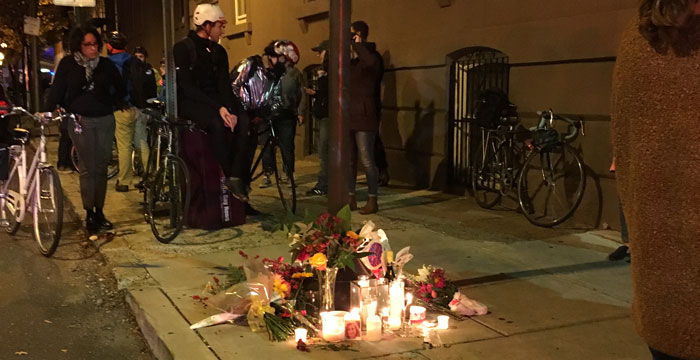
8 Ways Philly Could Make Streets (and Biking) Safer
On Tuesday morning, 24-year old bicyclist Emily Fredricks was killed by a person driving a sanitation truck at 11th and Spruce.
Two vigils were held yesterday. A human bike lane, an idea from Leigh Goldenberg, was formed at 7:30 AM. The Bicycle Coalition of Greater Philadelphia and 5th Square held a vigil at 5 PM.
After Tuesday’s tragedy, many in Facebook groups like Women Bike PHL and UrbanPHL are talking about problems and possible solutions. As PlanPhilly reported, Philadelphia won federal grants last spring to improve bike infrastructure, including physical barriers like plastic delineator posts. There were also plans to restripe the bike lane, where lines have faded for next month. Randy LoBasso published a plea from the Bicycle Coalition to restripe these lanes as recently as November 17th.
How can Philly advocate for safer streets? Here are a few ways, from the practical to innovations inspired by other cities.
8 Ways Philadelphia can Create Safer Streets
- Add physical barriers to existing bike lanes. Uh, i.e., from the funding they already have?
- Create loading zones at the end of streets for delivery trucks. As Amazon and the delivery culture prevails, distinguishing a loading zone will prevent drivers stopping mid-street or parking in bike lanes, forcing bikers to weave from the bike lane into traffic.
- Copying the West Chestnut Street Bike Lane layout. Creating a Bike Lane next to a lane of parked cars increases bike safety, increase of cyclists (which reduces cars on the road) and dramatically improves bicyclist behaviors. Drivers can rejoice: as the Bicycle Coalition explains, bicyclist behavior improves with improved infrastructure.
- Corner refuge islands: This creates a physical barrier from the bike lane into the intersection, protecting bicyclists as they make right turns and protect those from moving cars while at a red light. This also forces cars to slow down and stay in their lane as they turn.
- Enforce road violations. Driving in Philadelphia is the wild west – cars are rarely stopped or ticketed for traffic violations.
- Bike traffic lights. Similar to the Idaho Stop (meaning bikes slow down, yield and continue through intersections if no cars are coming through, which is safer for the cyclists going on momentum vs. zero to 35 MPH cars), bike traffic lights allow different triggers for bikes to make fewer stops and add buffer room between vehicles.
- Charge a fee for cars driving in Center City during business hours. When I lived in London, they had recently implemented a congestion charge for all vehicles operating in the city. Sure, this is a pipe dream for Philadelphia where cars freely park in the middle of Broad Street without ticketing. But London has reduced pollution and traffic has dropped slightly.
- Create a raised Bike Superhighway. Paris began building a 28-mile network of raised bike-only highways to make their city more bike and pedestrian friendly, along with reducing air pollution.
Unfortunately, a lot of these ideas are pushed back by the “Philly cars-first” culture. These objections are evident on social media, Philly.com’s comment section and occasionally the media. (We rebutted a Philly Mag post tormenting cyclists in 2011.)
If you’re a new to biking, think like a car. Train yourself to ask questions like asking if a person will jet out, stop suddenly and leave room between vehicles.
For those who drive in the city, a quick plea. You’re driving a 2000-pound vehicle with a primary intention to get from point A to point B. When we ride a bike, our first purpose is often to stay alive and avoid a collision. Please consider that other’s lives are at stake when you’re texting, playing on your phone, straying from your lane or blaring your horn. As James Kennedy said in UrbanPHL yesterday, “I often tell friends that a driver beeping at me feels about as dangerous and threatening in my day as if I had a gun pulled on me in an alley.”
We all live fast, busy lives. But we really all just want to live them without senseless tragedies.









